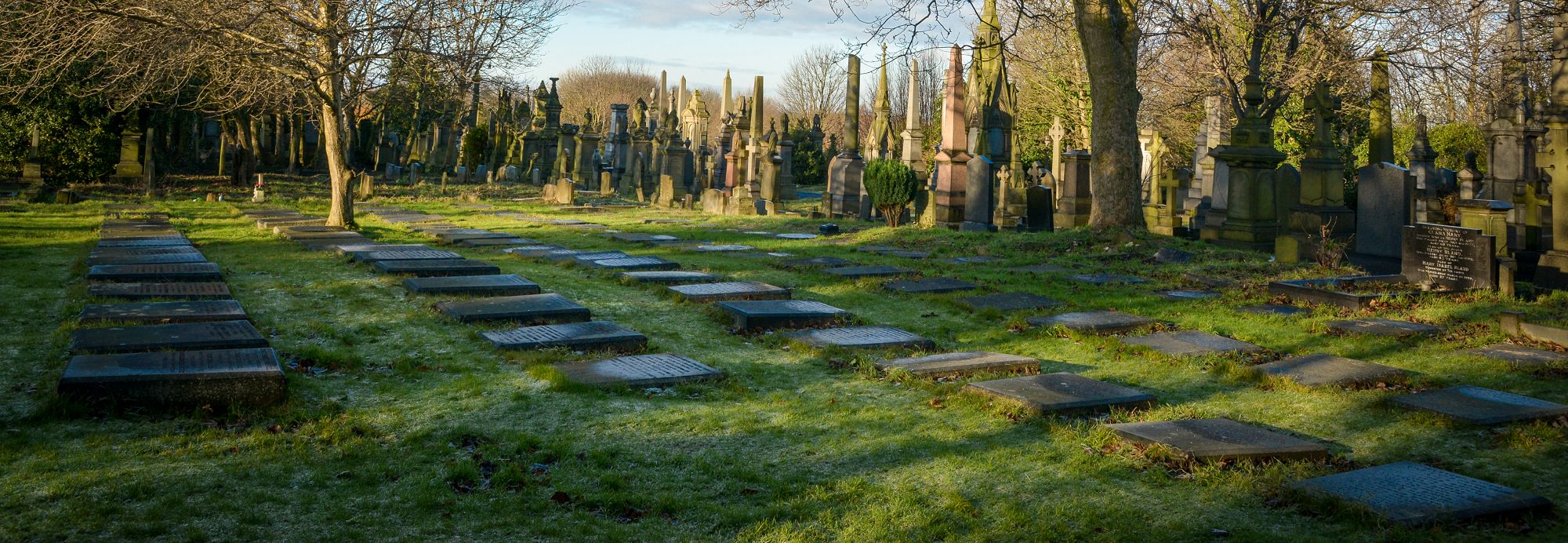Briggs Priestley
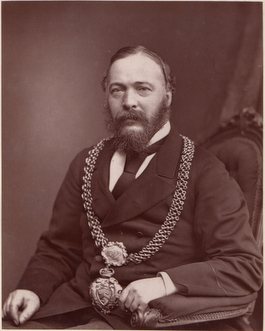
Briggs Priestley was born on 16 March 1831 in Thornton near Bradford, baptised on 12 October 1831 at the Independent Kipping Chapel at Thornton, the son of Samuel Priestley and Mary (née Margerison) who were married on 28 October 1829 at Dronfield, Derbyshire. He started work as a ‘market man’ for Craven and Harrop and later became a partner with Francis Craven while still a young man.
When a milliner he married Grace Crabtree, (born in 1827, the daughter of a Primitive Methodist preacher of Lincolnshire and a servant in 1841 at Colsterworth, Lincolnshire) between October and December 1852 in Bradford and went on to have 4 sons and 2 daughters.
In 1860 he left Thornton to go into partnership with his brother Henry Priestley running H&B Priestley, a small manufacturing business, in part of the Shearbridge Shed, Bradford. A fire there sent them on to Bee-Hive Mills in Thornton Road and the business grew to such an extent that they had to move to Albion Mills at Laisterdyke in 1863. More on this later on.
In 1861 the family lived at 175 Little Horton Lane, Bradford, Briggs 30 a Worsted Stuff Manufacturer employing 226 men, Grace 33, Charles Henry 7 b.1854 and a scholar, Sophia 5 b.1856 also a scholar, Emily 3 b.1858, William Edwin 2 b.12 April 1859 in Thornton and Arthur 0(!) b.1860. They had two female General Servants.
Briggs was elected as representative for Little Horton Ward on the town council in 1867. At the time he was residing in Trinity Terrace and had not been long on the Council when a proposal was made for the acquisition of Lister Park at a cost of £40,000 as it only possessed Peel Park and he was the leader influencing the provision of other parks. After much opposition Lister Park was acquired and also Horton Park. He became Mayor in 1877-78 and Alderman in 1879. As mayor, Briggs opened Horton Park on 25 May 1878. More on this later on.
Before the passing of the Education Act he established and maintained the New Leeds Orphan School to give orphans and the children of widows and widowers in destitute circumstances an education, allowing their parents to take up work knowing that their children were being looked after. He established two other schools of a similar nature, one in Pine Street, Bolton Road and the Ragged School in Rebecca Street, Manchester Road in all feeding, clothing and educating up to three hundred children. (Ref Yorkshire Past and Present).
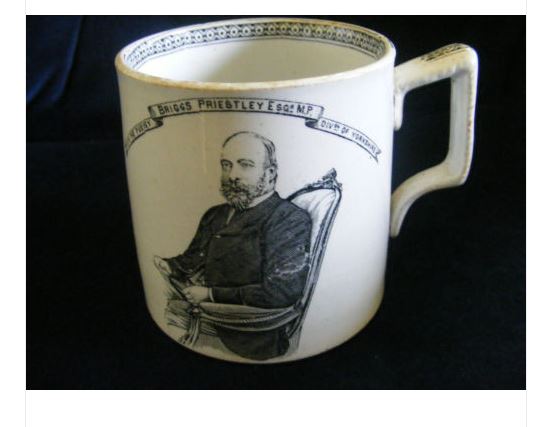
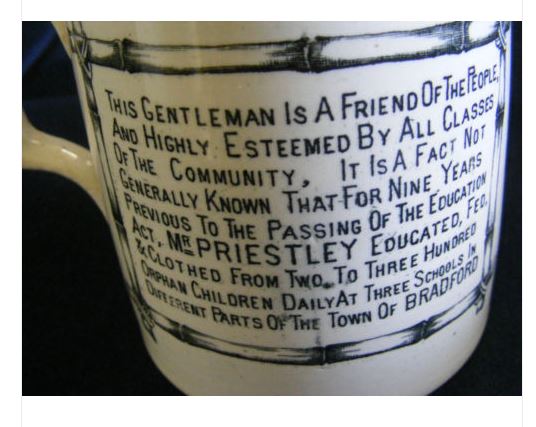
Briggs social services life is best illustrated in his mug (above). The inscription reads: –
This Gentleman is a friend of the people and highly esteemed by all classes of the community. It is a fact not generally known that for nine years previous to the passing of the education act, Mr. Priestley educated, fed & clothed from two to three hundred orphan children daily at three schools in different parts of the town of Bradford.
Briggs took a leading part in the foundation of the Nutter Orphanage, giving 1000 guineas towards the cost of the building.
Briggs was a member of the Infirmary Board and served as a Poor Law Guardian. He was a member of the Council of the Bradford Chamber of Commerce and a member of the Bradford Bench of Magistrates. (Ref Historical Notes on the Bradford Corporation by Cudworth)
In 1870 Briggs and his brother Henry built a shed to take 500 looms.
In 1871 the family was living at 60 Ash Well, Manningham, Bradford, Briggs then 40 and a Worsted Manufacturer employing 700 people with Grace 44, Charles Henry 17 and a Worsted Manufacturer Apprentice, William Edwin Briggs 11, Arthur 10 and James Herbert 9 b. 1862, all three scholars. They had three Domestic Servants (2 female).
At Laisterdyke, the Junction Shed holding 200 looms was taken in 1873. Subsequent extensions were the Dole Mill at Thornton with 400 looms in 1878 and Springfield Mill at Idle running 170 looms. Briggs was a Cloth Manufacturer and pioneered the manufacture of waterproof fabrics.
Before Bradford had a Free Library, Briggs established and maintained a library of 1200 books. He went on to initiate the establishment of the Free Library donating his books and to its move to Darley Street in January 1878 and opened the Art Gallery in May 1879 when he was elected an Alderman, holding the post for two years.
In 1881 Briggs was not to be found in England; perhaps on business abroad. The rest of the family were living at Fern Cliffe, Calverley, Bradford (otherwise referred to as Ferncliffe at Apperley Bridge), Grace 54, Sophia 25, with William E. B. 21 & Arthur 20 both Stuff Manufacturers. They had five Domestic servants: Cook, Waitress; Kitchen Maid & two Housemaids. NB Emily & James Herbert are missing – both not found in England; were they abroad with their father?
Their company exported to the US and when they took over the firm of Rule, Greenless & McEwans the firm became the limited company of Priestley’s Ltd. This amalgamation of Briggs Priestley & Sons with the Bradford branch of Messrs. Rule, Greenless & McEwans was officially completed in April 1901.
An advanced Liberal, he became President of the East Bradford Liberal Association and in 1885 whilst residing at Ferncliffe, Calverley he was elected MP for Pudsey district and served through until October 1899. He donated the Pudsey Band Stand to the people of Pudsey and was the one that officially opened Pudsey Park with a ceremonial silver key in 1889. He attended Trinity Baptist Chapel in Horton Lane where he took much interest in the Sunday School, was also Superintendent at the Kipping Sunday School for many years and in September 1906 at the Annual Meeting of the Bradford Mechanics Institute elected as President. Not only that but he was also Director of the Bradford & District Bank.
When Briggs entered Parliament he left his two sons whom he had taken into partnership to take care of the business. When his eldest son Charles Henry who resided at Cottingley Hall, Bradford Road, Bingley died in 1893 (see below), Briggs and his second son Mr. William Edwin Briggs Priestley became the sole partners. William was a mill hand who became a major mill-owner in Bradford. A Liberal politician, Mayor of Bradford from 1904 to 1905 & MP for Bradford East from 1906 to 1918 resided at Rosemount House, Bradford. Sir William was given his Knighthood in the Kings Honours list in 1909. He died on 25 March 1932 and is buried in Undercliffe Cemetery. Regarding his other two sons, Arthur Priestley who resided at Hungerton Hall, Grantham, Lincolnshire became MP for Grantham after being a manufacturer in America for three years and James Herbert Priestley was in business in Philadelphia as a spinner for three years but died in 1885 at the age of 24.
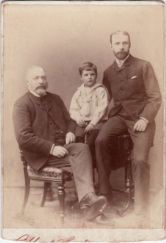
This photo taken by the Sachs studio c1885 shows Briggs Priestley with his eldest son Charles Henry Priestley and Charles eldest son John Gillies Priestley. Charles and his wife Annie Ford Gillies (married between October and December 1878 in Bradford) had another son Arthur Geoffrey Briggs Priestley born in 1883 in Bradford.
Briggs outlived his son and Charles Henry Priestley died in Algeria in 1893 at the age of 39 . His body was returned to Bradford in a leaden shell and this was placed in a huge Oak casket. The reason for him being in Algeria and the cause of his death would require further research. Charles was buried at Bingley after a grand funeral. He was connected with the Bradford Artillery volunteers and 100 members of the Corp including officers attended the funeral, along with the band, and about 300 of the workers of Messrs Priestley.
John Gillies Priestley born 10 December 1879 was just a young lad in this photograph and grew up to be a very educated man; he studied at Eton and Christchurch, Oxford and became a Doctor of Medicine. Whilst working in collaboration with John Scott Haldene (his Oxford mentor) in 1906 he discovered the role that too much carbon dioxide can play in producing the phenomenon known as the bends. (Ref T & A 18th Nov 2006). John Gillies had lived at the old Cottingley Hall. Coincidentally, in 1901 he was a 21 year old medical student staying at the Hotel Birlington (nowadays Burlington Mansions) in Owls Road, Boscombe, near Bournemouth with his grandfather Briggs Priestley, then just a widower of 70, his Aunt Emily Priestley 34 & his mother Annie F. Priestley a widow of 45. Why they were all there is beyond conjecture. [The hotel was run by Thomas Stagg (the Hotel Manager) and his staff of 28 looking after 84 guests]
In January 1900 the handing out at The Nutter Orphanage of Christmas gifts was reported, attended by the mayor & mayoress and Mr. Briggs Priestley, who addressed those gathered.
Briggs wife Grace died in July 1900 in North Bierley, Nr. Bradford, Yorkshire. The funeral took place at Undercliffe Cemetery after a short service at Ferncliffe, Apperley Bridge. Chief mourners were Mr. Briggs Priestley, Miss Priestley [presumably Emily], Arthur, Charles, Gillies and Geoffrey Priestley, Mr. & Mrs. William Priestley, Misses Gracie & Frieda Priestley and other Priestley family members. Carriages were sent by Messrs. William & Charles Priestley. A large number of beautiful wreaths were placed at the grave.
In November 1900 Mr. Briggs Priestley attended and was re-elected as one of the two Treasurers of the Nutter Orphanage.
In August 1901 the Liberals of Grantham gathered at Hungerton Hall by kind permission of Mr. Arthur Priestley, MP, for a country holiday and picnic, accompanied by his father Mr. Briggs Priestley and his sister Miss Priestley. There were 500 guests and the Borough Band was in attendance. Arthur was thanked by his father in his address to the throng for he had touched the hearts of the people.
In October 1902 Mr. Briggs Priestley as Treasurer of the Northern Counties Education League presented the monthly statement of accounts which were healthy.
In December 1904 there was a stone laying ceremony for the Bradford Children’s Hospital. This was conducted by Miss Priestley [presumably Emily]on behalf of her father, who was prevented from attending owing to the unfavourable weather; the wisdom of this decision was beyond question. Her brother Alderman William Edwin Briggs Priestley, president of the hospital, presided over the proceedings. Miss Priestly, using a silver trowel presented to her, eventually declared the stone to be “well and properly laid” to which she received much applause. Mr. Briggs Priestley had forwarded a cheque for £200 towards the £1700 cost of the extension to the building.
In June 1906 at the Wesleyan Sunday School Mr. Briggs Priestley handed out bags of sweets at the event which started out at the school and ended in a field in Stockhill Road. Also the Primitive Methodist Sunday School hymn singing on Whit-Monday held at Ferncliffe with Mr. Briggs Priestley handing out bags of sweets ended with outdoor sports.
Briggs himself died aged 75 about half past 2 on 21 October 1906 at Ferncliffe, Apperley Bridge very quietly afyer a long illness. On his death the great bell at the Town hall was tolled. On Wednesday 24 October 1906 he was buried in Undercliffe Cemetery starting at 10:00 am with a short service held at Ferncliffe, collecting the Cortege at 11:15 am near Eccleshill Parish Church where the Chief Constable headed the sad procession including 300 workpeople. His remains were encased in a metallic shell and plain oak coffin with brass mounts and an inscription with only his name, date of birth and date he died. The chilling drizzle all through the morning did not hinder the citizens of Bradford attending the funeral in crowds. The coffin bearers were old servants from the works at Thornton, Laisterdyke & Idle. There were over a hundred private carriages, many laden with wreaths, brought up the rear of a cortege a mile and a half long. Principal family mourners were his son William with his wife Ruth, son Arthur, his daughter Miss Priestley[presumably Emily], his daughter-in-law Mrs. Charles Priestley, Mrs. Gillies Priestley, grandson Gillies Priestley, nephew Mr. Thomas B. Priestley, grandson Mr. Geoffrey Priestley, Mr. J. Gillies, nephews James & Henry Priestley and Miles Priestley. At the graveside an autumn sun burst through the clouds. The vault situated in the Nonconformist part of the Cemetery was on the North side of The Terrace, a little beyond the Chapel. Also in it were Frederick who died in 1866 aged 12, James Herbert aged 25 (died in 1886) & Mrs. Grace Priestley (Briggs wife) who died in July 1900.
There were several obituaries made at the time – here are a few: –
The death of Mr. Briggs Priestley, a Captain of Industry in a strenuous and successful life, was not unexpected because as far back as September 1904 he had an apoplectic seizure. He had been confined to his house since August 1905 when he had an apoplectic stroke. On 16 October 1906 he had another seizure and had remained unconscious, his condition leaving no hope for recovery. His surviving son (then Mayor of Bradford) was Alderman William E. B. Priestley.
Briggs rose from humble beginnings to commercial greatness. On the walls of his library at Ferncliffe there hung an illuminated address which was presented to him in 1870 by the Factory Half-Holiday Association in recognition of his labours on their behalf. In his sons his political traditions were carried on: Mr. Arthur Priestley was elected to the House of Commons for Grantham in the 1900 election and Mr. William Priestley was one of the most prominent and influential of Bradford Liberals who won East Bradford by a large majority over the Conservative and Labour opponents.
The Mayor at the next meeting of the Bradford City Council emotionally referred to the death of Briggs Priestley and stated much praise for his career, character and achievements. The Prime Minister (H. Campbell-Bannerman) sent a letter of condolences dated 22 October 1906 to Alderman William E B Priestley, MP. It stated that his father was an old friend and knew few, if any, better men.
On 21 June 1907 at the annual meeting of the Bradford Tradesmen’s Home it was stated that there had been 4 deaths during the year at the institution. There were 43 houses belonging to the institution. The committee recorded with deep regret the death of Mr. Briggs Priestley.
In his will dated 17 July 1905, proved late in December 1906, he left £282,495 gross of which the personal estate was £276,172. He bequeathed his watch and gold key presented to him on the opening of Horton Park to his grandson John Gillies Priestley. His estate, Ferncliffe, to his trustees on trust to allow his daughter Emily to occupy same for not more than two years and subject for his son William Edwin Briggs Priestley but charged with the payment to his son Arthur Priestley of £5000. To each of his three nieces, daughters of his late brother Henry, and to each of his three nieces , the daughters of his late brother Thomas, £150. For the benefit of his nephew Thomas Bolton Priestley, or his wife, £450, and to his three children Emily Priestley, Thomas Edwin Briggs Priestley and Arthur Priestley, £350.He left £350 for his servants and £1000 for his work people or late employees of the firm of Briggs Priestley & Sons or Priestley’s Ltd. Another £1000 was left to the Nutter Orphanage for boys of Bradford and £500 to the Bradford Tradesmen’s Benevolent Institution. The residue was to be divided in equal parts: 4 parts for William E B Priestley, 2 parts for Arthur Priestley & Emily Priestley and 1 part each for his grandsons John Gillies Priestley & Arthur Geoffrey Priestley (children of his late son Charles Henry Priestley).
On the 25 June 1909 it was reported that Ferncliffe, Calverley, the fine residential estate which for many years was the home of the late Mr. Briggs Priestley, has been purchased by Alderman Fred Foster, a well known Bradford Wool Merchant. Ferncliffe is a mansion which was built about 1855 and in 1873 it came into the possession, on lease, of Mr. Briggs Priestley, who subsequently purchased the freehold for about £25,000 (approx. £2.7M in today’s money!)
Sir William Edwin Briggs Priestley became a Kt Bach (Knight Bachelor) on 22 June 1909 and was dubbed at Buckingham Palace on 22 July 1909 but this was effective from the 22 June 1909. [The reason for receiving the accolade, rank or position has only been given after 1970.]
In the Leeds Mercury of 29 March 1932 it was reported that on the 25th March 1932 Mr. William E B Priestley, Kt JP died in his 73rd year at Rosemount House, Bradford, husband of Ruth Priestley. Service to be held at Westgate Baptist Chapel on 29 March at 11 am. No mourning or flowers.
Perhaps a little more should be said of these two famous sons which illustrate their family virtues:
First the marriage of William E B Priestley to Ruth Craven, her family surname being one of the most respected in Yorkshire. They were married in April 1883 in Bradford. It was a fashionable marriage at the Kipping Chapel, Thornton. Miss Ruth Craven was the fourth daughter of Mr. Joseph Craven of Ashfield House, Thornton. There were no bridesmaids; nor was there any decoration of the Chapel, the marriage being one of the most unostentatious character. The bride and bridegroom have proceeded to Italy to spend their honeymoon. A large number of pretty and costly presents were received.
Next : Sir Arthur Priestley:
He was born on 9 November 1860 in Bradford, educated privately, well travelled and became a Liberal politician & cricketer and MP for Grantham from 1900 to 1918 and JP for Grantham & Lincolnshire and Mayor of Grantham from 1914 to 1917. As a cricketer he played for the MCC and led overseas touring sides from 1894 to 1897. He participated in some strange sports, like pig-sticking in Patiala to crocodile-shooting on the White Nile. He resided in Bath Club W and Hungerton Hall, Wyville, Grantham in 1918. He was Knighted (became a KT Bach) on 23 February 1911 by the King at St James Palace. His knighthood being awarded in the New Years Honours List on 2nd January 1911. He died unmarried on 10 April 1933 either in Nice or Monaco aged 68 or 72 (which is correct) depending on which paper you read (Nice being quoted by The Times).
To find the location of Briggs Priestley’s grave using the what3words App follow this link and select satellite view.
Briggs Priestley’s grave is in Uncon H6
Research by Steve Lightfoot & David Broomfield

